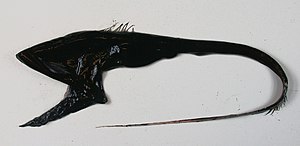Pelican eel
| Pelican eel | ||||||||||||
|---|---|---|---|---|---|---|---|---|---|---|---|---|

Pelican eel ( Eurypharynx pelecanoides ) |
||||||||||||
| Systematics | ||||||||||||
|
||||||||||||
| Scientific name of the family | ||||||||||||
| Eurypharyngidae | ||||||||||||
| Gill , 1883 | ||||||||||||
| Scientific name of the genus | ||||||||||||
| Eurypharynx | ||||||||||||
| Vaillant , 1882 | ||||||||||||
| Scientific name of the species | ||||||||||||
| Eurypharynx pelecanoides | ||||||||||||
| Vaillant, 1882 |
The pelican eel ( Eurypharynx pelecanoides ) lives in all temperate and tropical oceans at depths of 500 to 7500 meters. Most of the more than 250 animals caught so far came from the tropical Atlantic , from a depth of 1400 to 2800 meters. The pelican eel, which can grow up to one meter long, is the only known species in the Eurypharyngidae family .
features
Characteristic of the black colored animals is the large, high head and the huge, net-shaped and extended mouth, which contains several rows of tightly fitting, but only small teeth, the tips of which are bent backwards. The postcranial region (the area behind the brain) takes up most of the head. The eyes are small, the nostrils are close together. The gap in the mouth is longer than the distance between the tip of the mouth and the anus, which sits far in front, behind the first third of the total length. The gill openings are closer to the anus than to the end of the mouth. The pelican eel is the only teleostei (like some sharks and rays) to have five (instead of the usual four) gill-bearing arches. The tail takes up most of the length of the body. At the end of the tail there is a light organ , a tail fin is missing. Dorsal and anal fins are present, but end before the tip of the tail. On each side of the dorsal fin is a row of white pits of unknown function. The pectoral fins are tiny. Pelican eels have 100 to 125 vertebrae and are scaly. The lateral line organ has protruding tubercles instead of pores. Although the mouth is large, the stomach is not as flexible as in the related sac mouths (Saccopharyngidae). When they reach sexual maturity, males undergo extensive morphological changes. Your jaws will be reduced, so will your teeth, or they will be lost completely. The organ of smell becomes larger.
Way of life
The animals feed mainly on crustaceans, but also eat smaller fish, cephalopods and other invertebrates. Because of the small, non-stretchable stomach, they probably prefer smaller organisms as prey, which can be snapped open with the big mouth and - after the water that has been taken in with has been expelled through the gill openings - can be swallowed. The pelican eel is oviparous and the planktonic eggs hatch Leptocephalus larvae .
literature
- Joseph S. Nelson : Fishes of the World. John Wiley & Sons, 2006, ISBN 0-471-25031-7 .
- Kurt Fiedler: Textbook of Special Zoology, Volume II, Part 2: Fish , Gustav Fischer Verlag Jena, 1991, ISBN 3-334-00339-6
- DG Smith: Eurypharyngidae Gulper eels. Page 760 in FAO Species Identification guide for Fishery Purposes: The Living Marine Resources of the Western Central Atlantic, Volume 2 Bony fishes part 1 (Acipenseridae to Grammatidae) , ISSN 1020-6868
Web links
- Family Eurypharyngidae - Gulpers on Fishbase.org (English)
- Pelikanaal on Fishbase.org (English) (en.)
- Gulper Eel Balloons Its Massive Jaws on YouTube